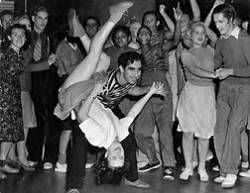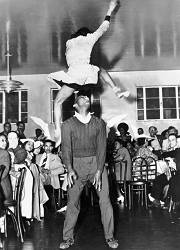Mad About Swing: the heart of Plymouth’s Swing Dance scene since 2007
What is Swing Dancing?

In its simplest form, swing dancing is any form of dancing carried out to swing music. However, there are specific swing dances that evolved alongside swing music between 1920 and 1940. Built around basic 6 beat and 8 beat patterns, the most well-known form of swing dance is Lindy Hop (sometimes referred to as Jitterbug or simply as Swing). Other popular swing dances include Balboa, Charleston and Shag.
Some people break Lindy Hop down into the sub-categories Savoy, Hollywood and Smooth Lindy but in our eyes these are simply different ways to style your dancing and are interchangeable, broadening the parameters of the dance.
Lindy Hop is a vernacular dance meaning that rather than conforming to concisely governed rules, it develops and grows as a result of improvisation and experimentation. The original Lindy Hoppers didn't learn their steps in formal lessons but copied steps from other dancers whilst inventing and sharing their own patterns and figures. Musicality is a fundamental and essential part of the dance and this is one of its biggest draws for us.
How it all began...

Swing dancing developed alongside the naissance of swing music in the early 20th Century. Lindy Hop was essentially a black dance, with its roots emanating from the folk dances of African slaves, and Harlem in New York formed the hub of its initial development. It was spawned from a fusion of dances such as The Breakaway, Charleston, Texas Tommy, Black Bottom and more structured European dances like the Foxtrot. The dance quickly spread to other parts of America and eventually to other parts of the world, most notably during WWII when GIs brought the dance with them to Europe. The most famous Lindy Hop dance troupe, Whitey's Lindy Hoppers, toured the world with it in the mid to late 1930s. Lindy Hop is credited with bridging the social divide between white and black as it united people at a time when segregation was precedent. When popular music shifted from the Jazz era into Rock 'n Roll in the mid 1950s, the popularity of Swing dancing faded and eventually petered out until the late 1980s when it experienced a revival. Since then the dance's popularity has gone from strength to strength.
When we first began dancing in 2003 we had no idea what swing dancing was and didn't have any swing records in our music collections. If someone had told us then that in a few years time our dance interests and listening tastes would lie heavily in the first half of the twentieth century we'd have said they were crazy. How wrong we would have been. Swing is our dance because, among many other draws, it offers so much scope for musical interpretation. For us, a lot of modern music, particularly pop music, just doesn't offer the same energy and diversity which is probably why 'dated' dances such as Lindy Hop have experienced such a successful revival and are rapidly gaining in popularity.

